Let me share something exciting. Our client’s Women’s Mental Health TeleMedicine Platform started from zero. In just one year? 250,000 users. Then things got really interesting. Over the next two years, the platform exploded to 2 million users. That’s when we knew—this wasn’t just another app. This was part of a healthcare revolution.
The global telemedicine market backs this up. It’s projected to reach USD 851.0 billion by 2032 at 25.7% CAGR. No wonder smart businesses are looking for ways to enter this booming space.
As developers of many healthcare applications, we’ve witnessed the incredible demand for telemedicine solutions. Teladoc and Amwell, leaders in telemedicine, have initiated new standards for medical service delivery. That is why entering this market requires thorough planning of development costs and investment strategies.
What are Telemedicine Apps, And What Makes Them So Valuable?
What has caused such a buzz around telemedicine? At their core, telemedicine apps are specialized software platforms that bring healthcare services to your digital devices. Think of them as virtual clinics that let you consult doctors, receive treatment plans, and manage your health—all through your smartphone or computer. These apps typically include features like video consultations, secure messaging, prescription management, and even vital signs monitoring.
These solutions offer businesses great opportunities. The overhead costs associated with traditional healthcare can be reduced by expanding their reach and streamlining operations. Medical practices can serve more patients, reduce no-shows, and manage their schedules more efficiently.
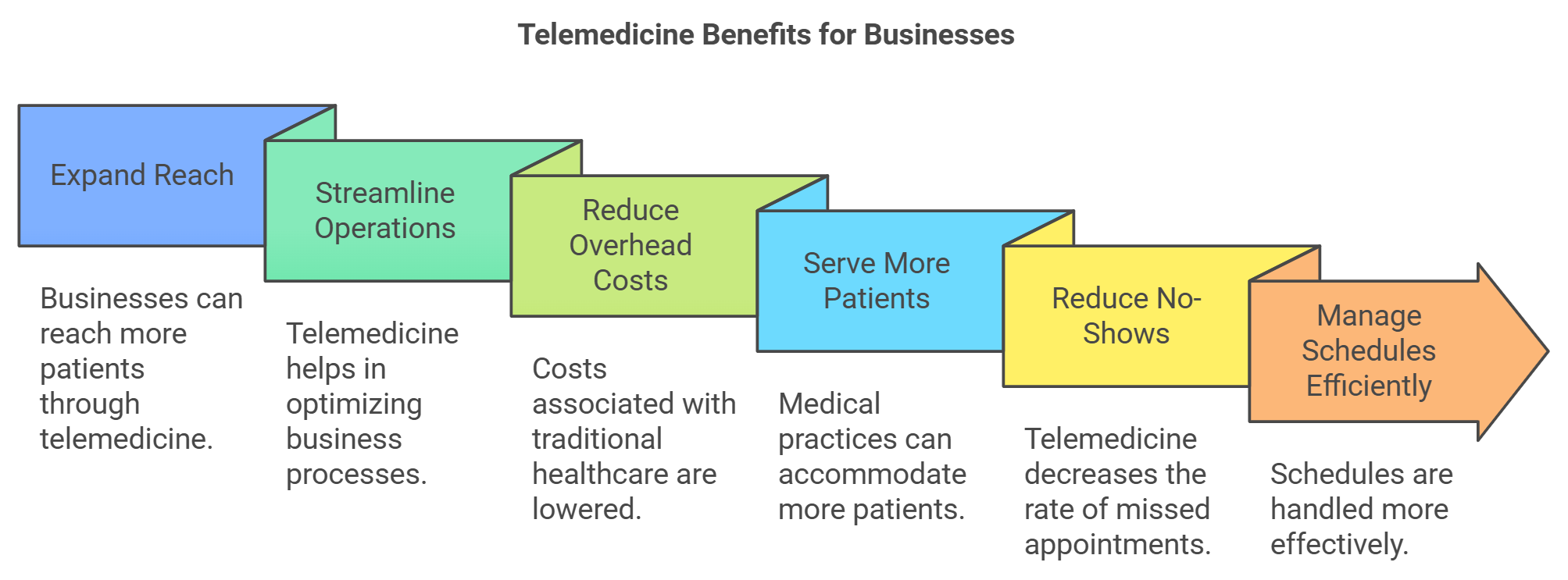
As for users, they offer convenience, less travel time, and easy access to medical expertise. No waiting rooms. You simply connect with doctors from your sofa and manage prescriptions with just a few taps. Telemedicine solutions are a trend that truly changes the way we approach health and wellness.
They empower both providers and patients. These apps are like lifeguards for people who need help. Whether it’s mental health counseling or urgent care, people can’t always get it because of where they live, how mobile they are, or how busy their schedules are.
Types of Telemedicine Apps
After knowing the value of telemedicine apps, it’s worth exploring the main types of telemedicine apps that are:
- Real-time video-conferencing allows you to connect with healthcare professionals remotely. This app provides a convenient alternative to in-person consultations. Although there are general video conferencing platforms such as Zoom, there are also specialized applications designed specifically for medical professionals. Teladoc is a prominent example of this.
- Store-and-Forward Apps. These apps, known as store-and-forward applications, allow healthcare professionals to share training videos and images with students and colleagues remotely. They are reachable 24/7 for all this stuff. Example: Zipnosis
- Remote Patient Monitoring (RPM). These remote patient monitoring apps use wearables and IoT (Internet of Things) technology to keep an eye on patients’ vital signs and health at all times. They use AI (artificial intelligence) to automatically send alerts to doctors when something is wrong, so there is no need for anyone to be watching at all times.Example: Omron (as wearable) and Body+ of Withings (as IoT).
- Mobile Health (mHealth) apps help patients find and schedule appointments with suitable healthcare providers. These solutions, like Square Appointments, have personal accounts and reminder features, making it easier for patients and healthcare providers to keep track of appointments.
- Apps for remote education for doctors use VR, AR, and 360-degree videos to make medical training more engaging. These apps, like virtual reality headsets and AR-enabled tools like Eye Handbook, offer immersive and interactive learning for healthcare workers.
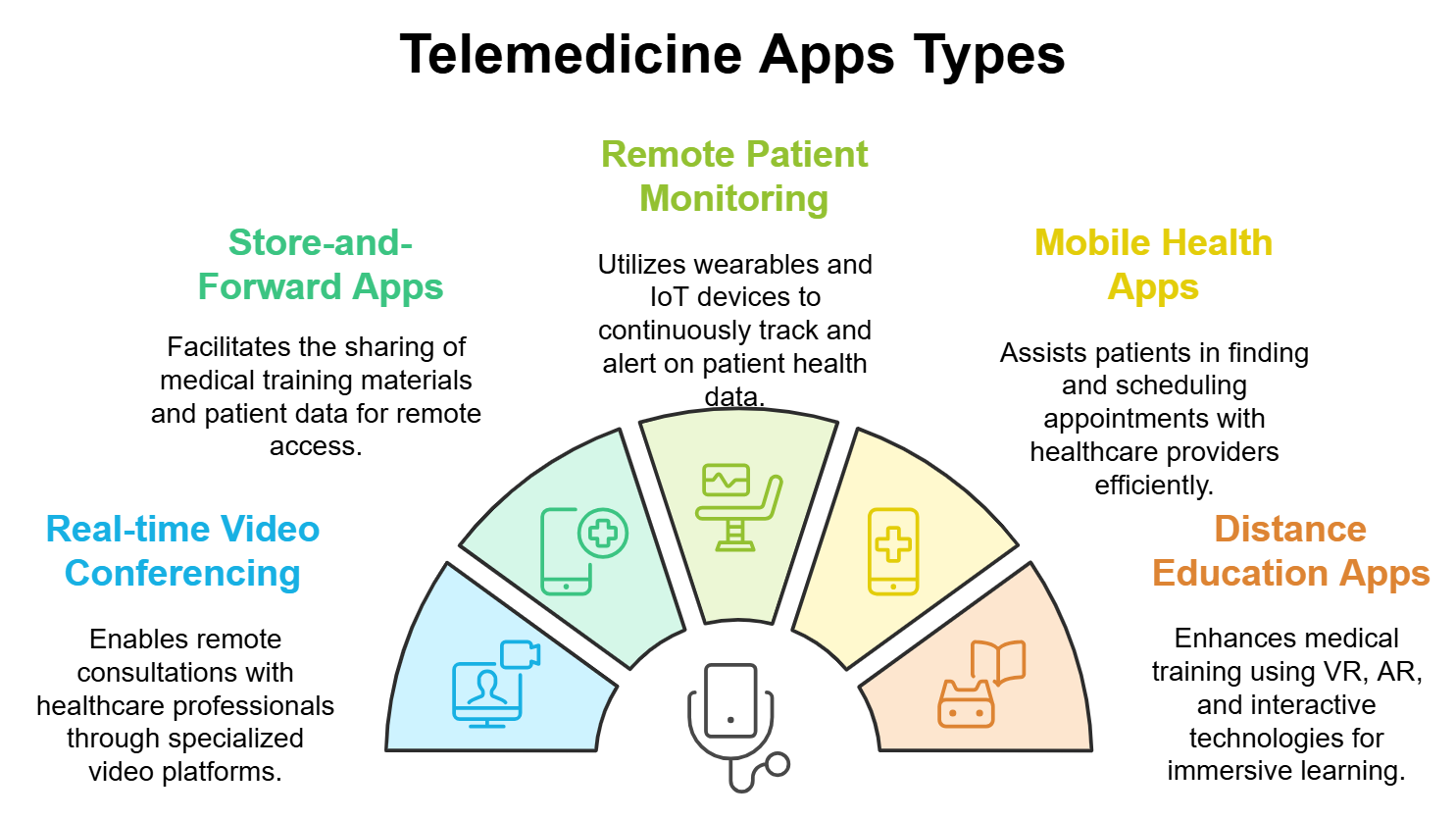
How Much Does It Cost to Develop a Telemedicine App?
A typical telemedicine app runs between $10,000 and $50,000, if you want to know the straight talk about costs.
In a decade of healthcare software development, we have seen it all – from simple consultation platforms to complex systems with IoT and AI diagnostics.
Having launched more than 20 healthcare solutions, the Itexus team knows exactly how to make your budget work while meeting all the critical medical software requirements.
Take our mental health consultation platform that we built just a couple of months ago. It’s a perfect example of a medium-complexity app featuring video consultations, secure document sharing, payment processing and basic EHR integration. The final cost? $46,600. That’s pretty reasonable for a fully functional telemedicine solution.
On the other end of the spectrum, we recently delivered an advanced telemedicine platform for $174,000. This one packed quite a punch—AI-powered diagnostics, complex EHR integration, multi-language support, and IoT device connectivity. This platform was packed with many more features than mentioned in the table above.
These examples show the real range of investment needed. Your specific costs will depend on your requirements and chosen features.
Want to explore what your telemedicine app might cost? Let’s talk about your specific needs.
| Key Features | Basic | Medium | Advanced |
| Basic Authentication | + | + | + |
| Basic Video Calls | + | + | + |
| Basic Patient Records | + | + | + |
| Basic Calendar | + | + | + |
| Basic E-prescriptions | + | + | + |
| Two-Factor Authentication | – | + | + |
| EHR Integration | – | + | + |
| Advanced Analytics | – | + | + |
| AI-powered Insights | – | – | + |
| Insurance Integration | – | – | + |
| Approximate Cost Range | $10,000 – $20,000 | $20,000 – $50,000 | $50,000+ |
Core Factors Impacting the Cost of Medicine App Development
Take a few crucial technical aspects. These aspects truly shed light on why expenses can vary so significantly.
Complexity of Features:
Last year, a client came to us wanting “just a simple telemedicine app” (we had to smile at the “just“). As we dug deeper into their requirements, that “simple app” evolved into a sophisticated unified patient EHR/EMR platform, with AI-powered hospital patient management systems. It also assembles and securely stores user health data.
It’s a story we’ve seen play out many times in our decade of software development—what starts as basic often grows into something more complex as the real needs emerge. That’s why understanding feature complexity from the start is crucial.
The more features a telemedicine app has, the more it costs to make. A simple app can have only basic features like scheduling appointments and video calls. It’s good for simple doctor-patient conversations. But if you add more complicated features, the app becomes more difficult to make and the cost goes up.
Here are some key factors that determine the complexity of features:
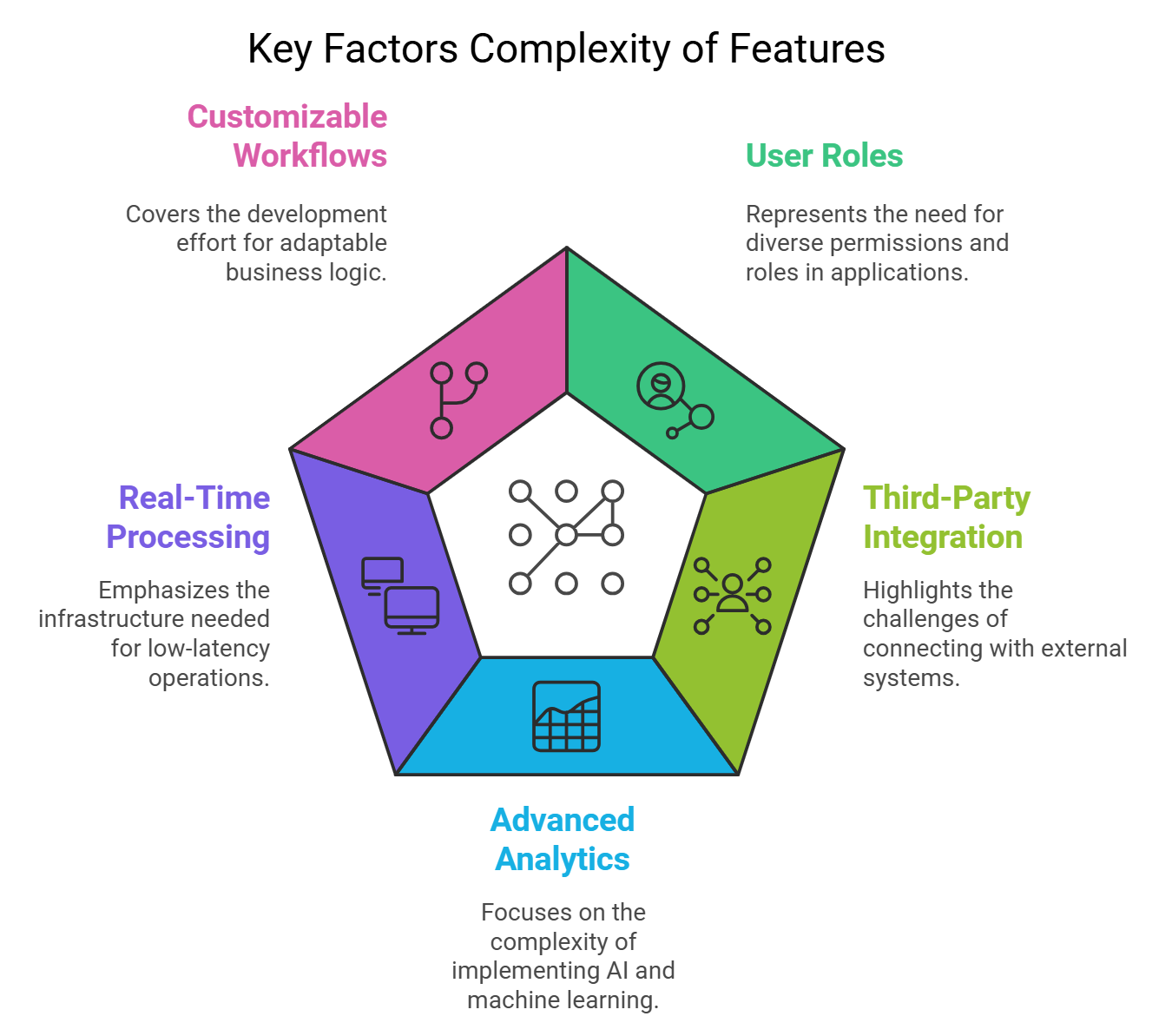
By understanding these factors, you can better plan and budget for your app’s development.
Development Timeline
“How soon can you launch it?” Ah, the question that makes every developer take a deep breath.
Be aware of telemedicine app’s development timeline typically ranges from 2 to 12 months, depending on complexity and scope. While a basic video consultation app might take 2-3 months, more sophisticated solutions require additional time for proper development, testing, and deployment.
Here are the key things that influence development timeline:
- Feature Complexity: More complex features like AI diagnostics or EHR integrations can add months to development compared to basic functionalities.
- Testing and Compliance: Healthcare apps require thorough HIPAA compliance testing and security validation, which impacts the timeline significantly.
- Third-party Integrations: Each external service (payment systems, video APIs, health monitoring devices) needs its own development and testing cycle.
Understanding these factors is essential for setting realistic timelines.
The Critical Role of Development Team Expertise
At Itexus, we’ve got a knack for understanding the nuts and bolts of healthcare technology because we’ve been through it—delivering over 10 years of healthcare solutions and counting.
Just recently, our team navigated familiar HIPAA compliance challenges. What is a big deal? It allows saving a client one month of development time.
Now, let’s talk location. Where your development team is based can make a world of difference, not just in cost but in the kind of expertise you’re tapping into. Costs can vary dramatically depending on the region, which impacts your overall budget. But here’s the kicker: it’s not just about the money. Different parts of the world bring varied skill levels, especially in critical tech areas.
So, what should you expect from a top-notch team? At Itexus, it’s not just about code. It’s about understanding healthcare inside out:
- Deep Healthcare Insight: Our team speaks the language of healthcare. We know the workflows, challenges, and what makes an app genuinely useful for providers and patients.
- Mastery in Security and Compliance: We’ve been there, done that with HIPAA and other regulations. Our secure, user-friendly systems set your mind at ease.
- Savvy Problem Solvers: We’ve encountered and conquered many industry-specific hurdles. This foresight often saves both time and budget—something our clients appreciate.
Whether you’re starting from scratch or looking to revamp your system, having a team that grasps both the tech and the healthcare landscape is key.
Curious about how we can bring this expertise to your project? We’re just a call or click away.
| Mobile app Complexity | Average timeline | Average cost |
| Basic with low level of complexity | 3 – 6 months | $10,000 – $20,000 |
| Medium level of complexity | 6 –12 months | $20,000 – $50,000 |
| Advanced with a high level of complexity | 12 – 18 months | $50,000+ |
Choosing the Right Tech Stack for Your Telemedicine App
At Itexus, we’ve learned that selecting the right technology isn’t just about picking trending tools. It’s about finding the perfect match for your specific needs. As a custom software development company, we’ve mastered combining reliable technologies with innovative solutions
Let’s break down what matters in telemedicine tech stack:
- Backend Stability: We opt for proven technologies like Node.js and Python. Why? They handle high-load video consultations smoothly while keeping your app responsive. Our recent telemedicine project serves 1,000+ daily users without a hiccup.
- Secure Data Management: MongoDB and PostgreSQL are our go-to databases for healthcare apps. They excel at managing sensitive patient data while meeting HIPAA requirements. Plus, they scale beautifully as your user base grows.
- Reliable Video Integration: Through numerous projects, we’ve found that WebRTC and Twilio work best for stable video connections. These solutions offer the right balance of quality and cost-effectiveness.

Technology choices can make or break your telemedicine app. Having a team that understands both the technical landscape and healthcare specifics helps avoid costly mistakes down the road.
I’m excited to show off some of our telemedicine projects.
- Mental Health App for Meditation:The app helps users with meditation and breathing practices. It includes integration with an electroencephalogram (EEG) device, which allows users to track their meditation progress by displaying diagrams and charts of brain activity.
- Telehealth Ecosystem for Matching Speech Therapists and People in Need of Therapy: A telehealth ecosystem connects individuals suffering from various speech and language disorders with therapists specializing in specific conditions. This ecosystem comprises an iOS mobile app for users, a web app for therapists, an admin panel, and a landing page.
- Telehealth Platform for Patients With Chronic Diseases: A telehealth platform that helps patients with chronic diseases find and connect with appropriate health practitioners for treatment.
- Patient-centric Unified EHR/EMR Platform: Patient-centric, AI-based, health record exchange platform that connects to a hospital’s patient management systems, and assembles and securely stores users’ health data. This platform allows patients to own their personal health data and share their information with other healthcare organizations should they choose to.
- TeleMedicine Platform for Women’s Mental Health: A telemedicine platform for women to access therapy, approach mentors for support and become mentors to others, and talk to other women in a safe, stress-free, and supportive environment.
- Design for Mental Health TeleMedicine Platform: Leverage Itexus profound expertise to create a strong design solution for your business.
Contact us for more info, a free consultation, and an estimate for your project.
Hidden Costs in Telemedicine App Development
While the fundamental expenses for development are more transparent, there are several additional factors that may not be immediately apparent. At Itexus, we prioritize transparency, ensuring that you are aware not only of the initial expenses but also of the potential obstacles that may affect your budget in the long run.
Let’s explore these unexpected expenses to enhance your budget planning:

How to Reduce Telemedicine App Development Costs
Maintaining cost-effectiveness without sacrificing quality is a delicate balance.
Here are the strategies we employ:
- Begin with the fundamentals: Itexus advises launching with essential features and expanding based on user feedback. This approach of creating a minimum viable product (MVP) helps to save initial expenses while enabling informed and strategic improvements.
- Opt for intelligent development strategies: Utilizing tools for multi-platform development not only expedites the process but also minimizes expenses. At Itexus, we are specialists in optimizing these efficiencies.
- Partner with healthcare technology specialists: Working with a team that comprehends the distinctive requirements of telemedicine, such as Itexus, guarantees that your application satisfies all criteria without unnecessary expenses.
These strategies reflect how Itexus delivers high-quality solutions and considers but the economic aspects of app development, aligning our expertise with your financial goals.
Must-Have Features in Telemedicine App Development
In fact, telemedicine app needs two well-designed interfaces – one for patients and one for healthcare providers. Let’s break down the essential features that make a telemedicine app truly valuable.
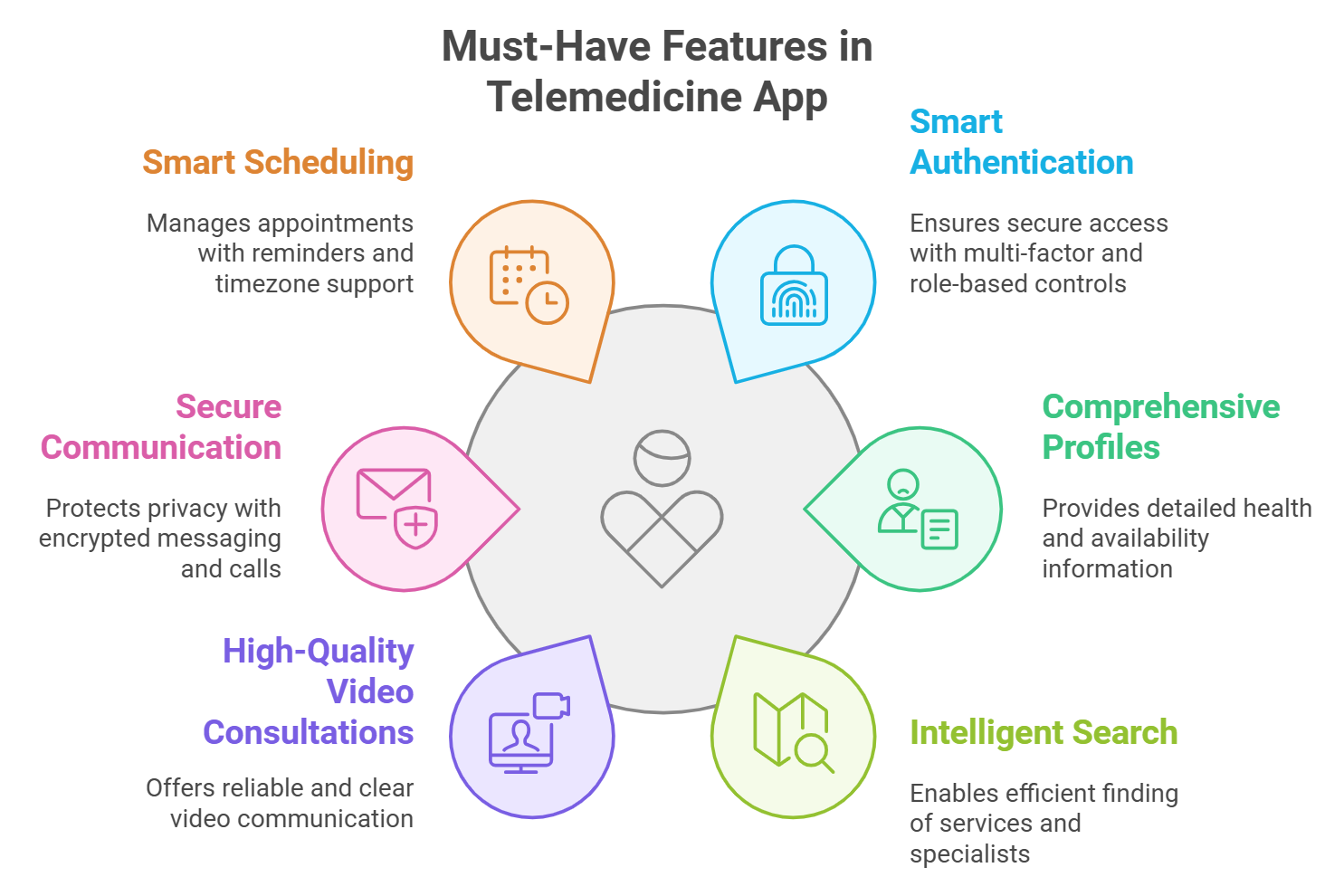
Each feature needs careful consideration of both technical capabilities and healthcare regulations. Having built multiple successful healthcare solutions, we know how to strike the right balance. For example, in our TeleMedicine Platform for Women’s Mental Health,, we have successfully integrated all these features to create a safe and user-friendly platform for patients and healthcare professionals.
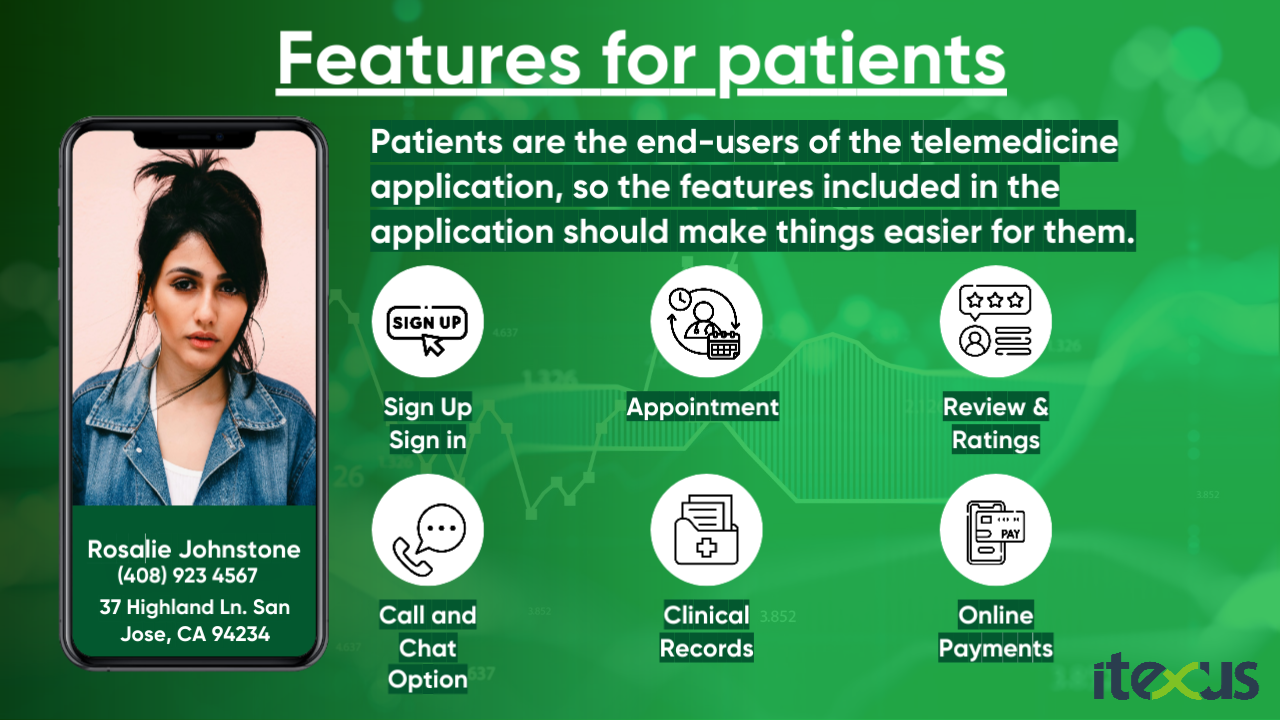
Smart Monetization Strategies for Telemedicine Apps
At Itexus, we understand what makes a telemedicine app stand out. It’s not just about great healthcare delivery. That’s about a solid revenue model too. We’ve helped loads of clients go from idea to profitable app.
So, want to make some money with your telemedicine app?
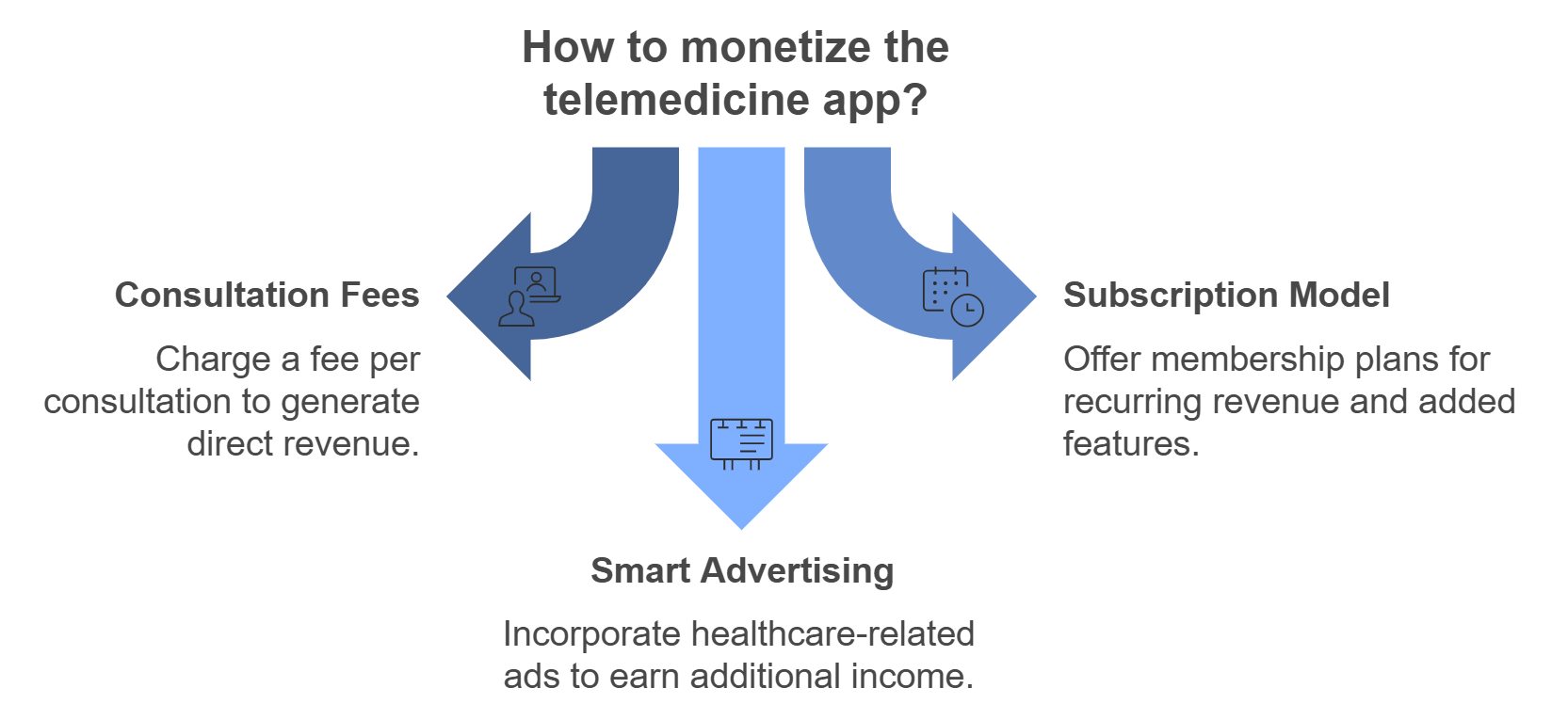
Here’s how!
Consultation Fees: Charge 20-25% per booking (like our Speech Therapy platform) For example, similar to the Telehealth Ecosystem for Matching Speech Therapists and People in Need of Therapy, which charges patients a 25% fee for accessing consultation features.
Subscription Model: Offer monthly/yearly memberships for regular users, or partner with companies for employee healthcare
Smart Advertising: Generate extra revenue once you build a solid user base
These monetization strategies can significantly enhance the financial viability of your telemedicine app.
How Itexus can be of use to you
We bring 12 years of healthcare tech expertise and 250+ specialists to your telemedicine project. Our track record? One platform alone connects 1 million+ patients, serving 1,000+ daily users through our Women’s Mental Health TeleMedicine Platform. We don’t just build apps—we create healthcare experiences that matter.
We’ve tackled HIPAA, EHR integration, and UX challenges for 24 healthcare clients.
Need a partner who truly gets healthcare tech? Let’s talk.
Wrapping It Up
Telemedicine apps cost between $10,000 and $50,000+, depending on features and security needs. Smart platforms pay for themselves through subscription fees and consultation fees. Having helped 24 healthcare clients, we know what works: balanced budgets, must-have features, and quick market entry.
With the right expertise and a cost-effective approach, your platform can achieve both financial success and meaningful healthcare outcomes.
FAQ
Q1: Are there any extra expenses after my telemedicine app launched?
Good point, indeed, your app is not just a one-off investment, as many inexperienced developers overlook. Here’s the real ongoing cost based on our experience:
– Server maintenance (and trust me, this is crucial for smooth operation):
Small scale (up to 10,000 users): $300-500/month ($0.03-0.05 per user)
Medium scale (10,000-50,000 users): $500-1,500/month ($0.02-0.03 per user)
Large scale (50,000+ users): $1,500-5,000/month ($0.01-0.02 per user)
– Regular updates and maintenance:
Telemedicine apps: 15-20% of initial development cost annually
Industry standard for medical software: 20-25% annually
Here’s a pro tip: Budget for these ongoing costs from the start. To avoid it, ask your developer to provide after launch costs.
Q2: How can I ensure my telemedicine app will be scalable as my user base grows?
A: Ah, scalability – one of the paramount factors for any successful app. I remember a client who had to rebuild their entire app because they didn’t consider it. Don’t make the same mistake! Here’s what you need to know:
Cloud infrastructure costs (and why they’re worth every penny):
– Cloud costs per 10,000 users: $500-1,000/month
– Traditional server costs: $1,200-2,000/month
The best part? You’ll see returns in just 6–8 months. Not too shabby for future-proofing your app!
Performance metrics (because every second counts in healthcare):
– Response time with optimization: 0.5-1.5 seconds
– Without optimization: 3-5 seconds
I’ve seen users abandon apps that take more than 3 seconds to load – in healthcare, that’s just not acceptable.
Q3: Do I need to implement all features at once, or can I start with basic functionality and add more later?
A: Let me share a success story: One of our clients started with basic features and grew to 2 million users. Their secret? A smart, phased approach. Here’s how you can do it too:
Phase 1 (MVP):
– Time to market: 2-3 months
– Initial investment: 40-50% of total budget
– User adoption rate: 60-70% of target audience
Quick tip: This is where you’ll want to focus on getting the basics absolutely right. We’ve found that users are more forgiving about missing features than they are about buggy ones.
Phase 2 & 3:
– Development time: Much quicker than starting from scratch
– ROI timeline: 8–12 months (compared to 12–18 months for a full launch)
To tell you true, the majority of users actually prefer this gradual approach. It gives them time to adapt to new features, and you get valuable feedback along the way.
Keep in mind, Rome wasn’t built in a day, and neither should your telemedicine app be. Start smart, scale smartly!